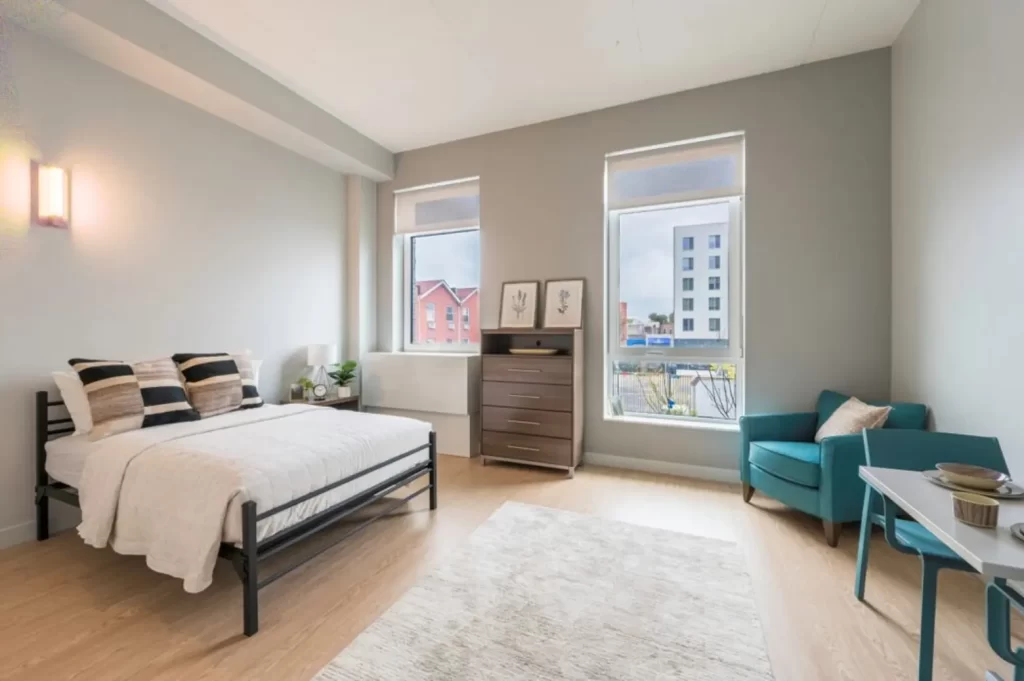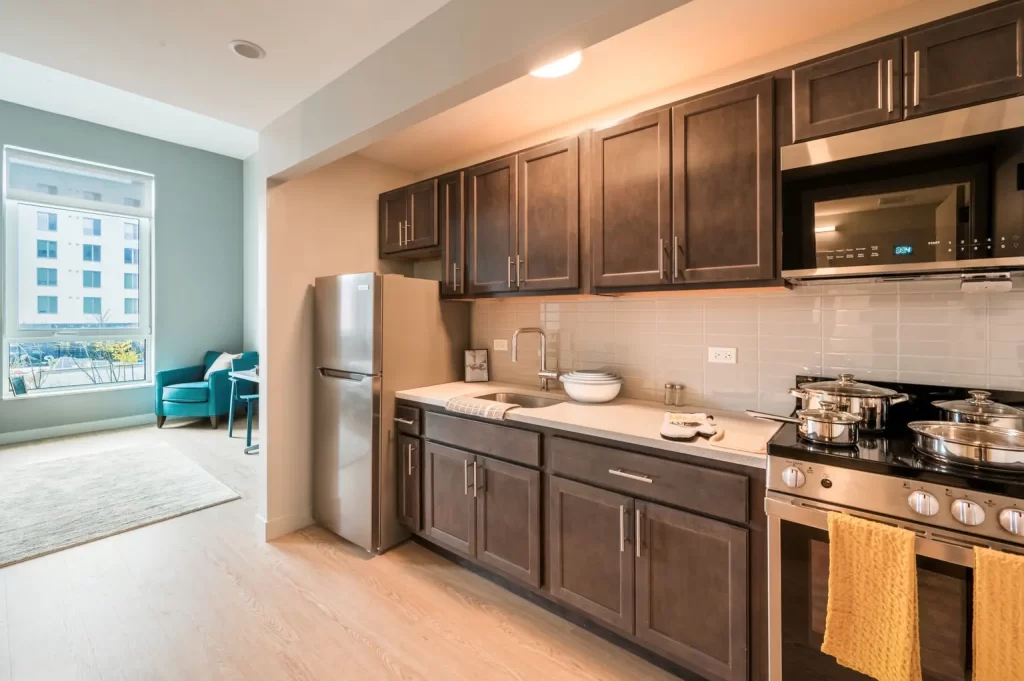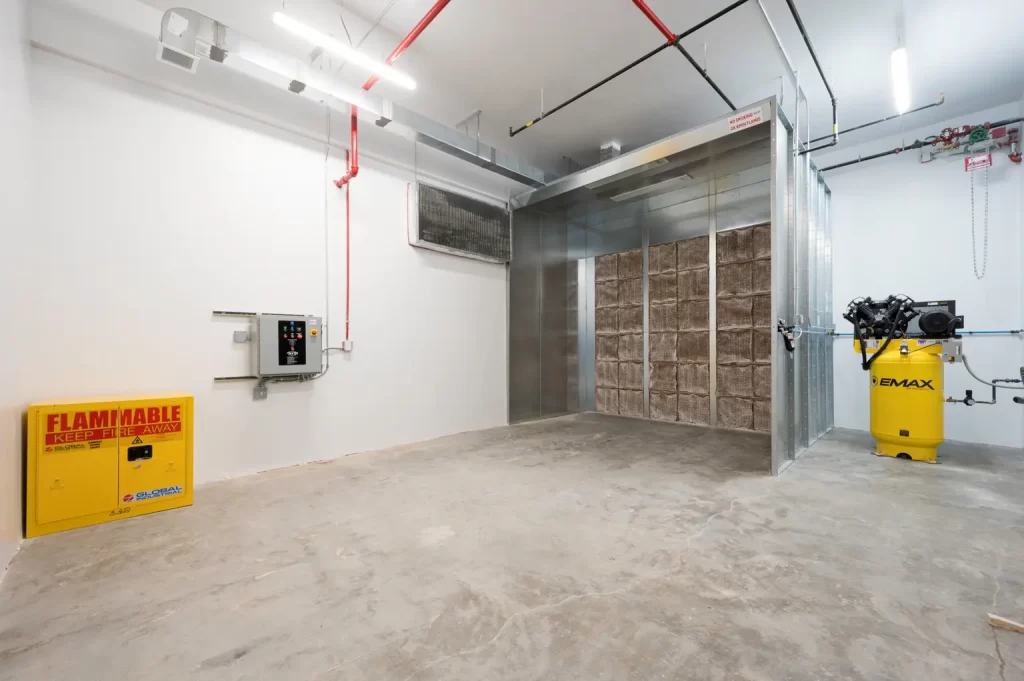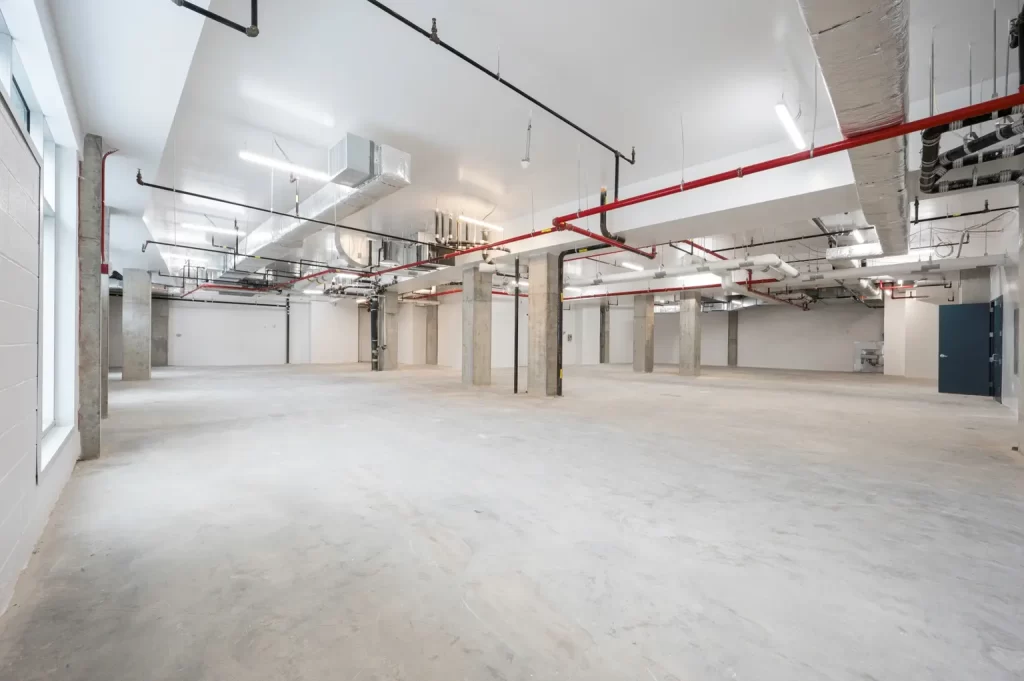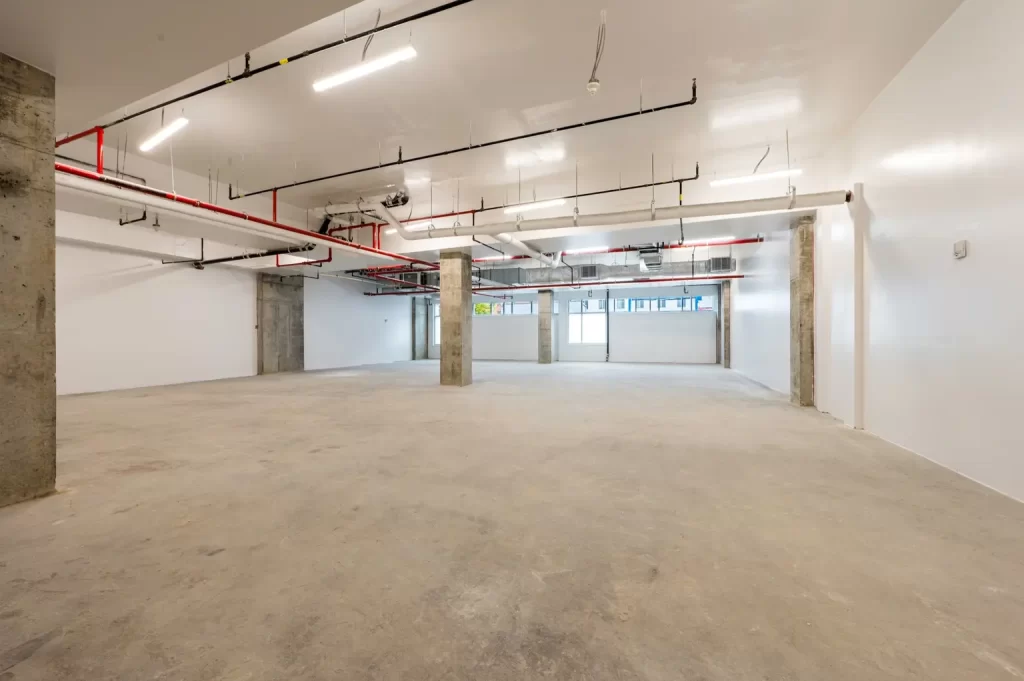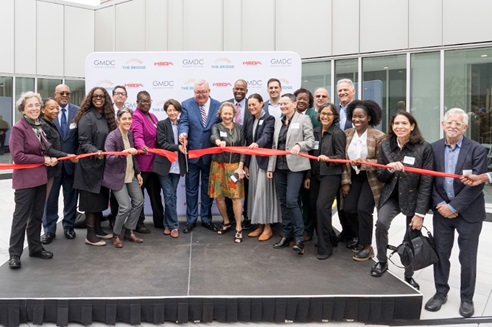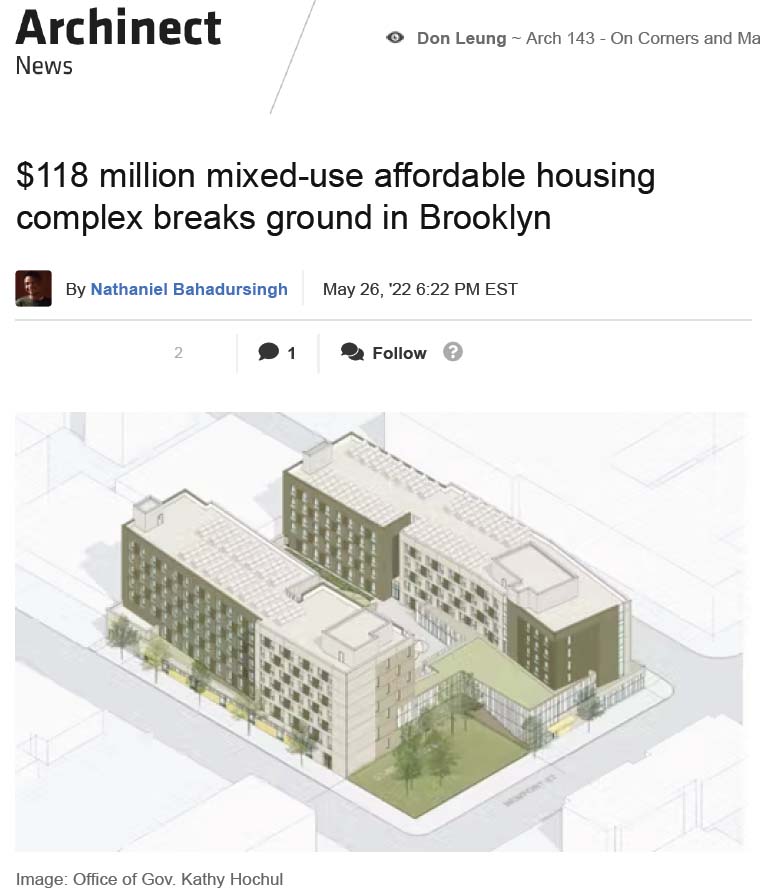GMDC, The Bridge, and Mega Development Celebrate Ribbon-Cutting for City’s First-Ever New Mixed-Use Housing and Industrial Development in Brooklyn
September 25, 2024, CityBiz
The GMDC Brownsville Industrial Center reimagines the former Fox’s U-Bet’s Chocolate Syrup Factory in Brownsville as 39,000 square feet of affordable, light manufacturing space.
Bridge Rockaway features 174 units of affordable and supportive housing, including set-asides for formerly homeless seniors, veterans, and adults living with serious mental illness.
Today, the Greenpoint Manufacturing and Design Center (GMDC), The Bridge, and Mega Development held a ceremonial ribbon-cutting for the first new, mixed-use residential and industrial development in Brownsville, Brooklyn. The $118 million project reimagines the former Fox’s U-Bet Chocolate Syrup factory at Rockaway Avenue and Newport Street as the GMDC Brownsville Industrial Center, 39,000 square feet of affordable, top-of-the-line light industrial space on the ground-floor; Bridge Rockaway, a residential building with 174 units of affordable and supportive housing above the industrial space; and a 2,000 square-foot community space, spanning half an entire city block. It is the first new project in New York City to co-locate affordable housing and industrial space on the same site, and a model for increasing affordable housing on underutilized manufacturing property while maintaining manufacturing use.
Senator Roxanne Persaud, Assembly Member Latrice Walker, NYC Executive Director for Housing Leila Borzorg, and other prominent city and state officials, as well as nonprofit and private partners joined GMDC, The Bridge and Mega at today’s ribbon-cutting ceremony to officially open the development.
“After nearly eight years of planning, development, and construction, we are thrilled to finally open our doors,” said Brian T. Coleman, CEO of Greenpoint Manufacturing and Design Center. “This project does what no one thought was possible: putting 39,000 square feet of light manufacturing space, more than 170 units of housing, and a community facility on the same site safely and affordably. Now, as we get ready to welcome our first tenants, I thank our partners at The Bridge, Mega Development, and at every level of government for supporting our vision to transform this block and create a stunning new home for businesses and residents in Brownsville.”
“When The Bridge conceived this project, our goal was to create much needed supportive and affordable housing while preserving manufacturing uses,” said Susan Wiviott, CEO of The Bridge. “This first of its kind project proves a concept that can be replicated across the city. I am deeply grateful to our entire development team, particularly Mega Contracting, Think! Architecture and Design, and GMDC for seeing this project through to completion. We look forward to welcoming our first residents early next week.”
“For too long, our zoning laws lived in the past, ignoring the realities of today and the bold possibilities of tomorrow,” said New York City Mayor Eric Adams. “This new development in Brownsville, Brooklyn is symbolic of the endless potential that still rests in our city. Affordable and supportive housing, industrial development, and community space all come together in one mixed-use development, transforming an entire neighborhood. When we open our doors and say ‘yes’ to housing, jobs, and opportunity, there’s nothing our city cannot do.”
GMDC, a nonprofit industrial developer and property manager with a portfolio of more than 685,000 square feet of industrial space across New York City, will own and operate the GMDC Brownsville Industrial Center at 805 Rockaway Avenue. The space includes 10 units, ranging in size from 1,250 square feet to 6,000 square feet, for light industrial uses that might include custom woodworkers, cabinet makers, and artisanal tradespeople, such as set builders and display makers, home goods manufacturers, metal workers and finishers, and garment makers, among others. It features a loading dock with hydraulic lift and a state-of-the-art finishing room for industrial tenants. In addition to these services and amenities, GMDC has invested more than $11.5 million in odor and vapor barriers, vibration isolators, acoustical treatments, and other abatement measures to ensure the safe coexistence of residential and industrial tenants. It is expected to create up to 35 direct jobs, in addition to indirect jobs and investment.
The Bridge, which operates supportive housing and behavioral health services for New Yorkers living with behavioral health concerns, will own and operate Bridge Rockaway at 203 Newport Street. The development consists of two residential towers- a six-story structure and a seven-story structure- separated by an 11,000-square-foot garden. Units will be affordable to residents earning between 30 percent and 70 percent of the Area Median Income (AMI) and 87 units will be set-aside for formerly homeless seniors, veterans, and adults with serious mental illness, with wraparound services from The Bridge staff on-site. In addition to access to the building’s vibrant garden terrace, residents will have access to a reception area with 24/7 staffing, a computer room, community rooms, a bicycle room, and storage and laundry facilities.
The 2,000 square-foot community facility, located at 432 Thatford Avenue, will be leased to a nonprofit organization, a community health facility, or a financial services institution.
This project was made possible through financial support from various public, private, and nonprofit sector partners, including JPMorgan Chase, Enterprise Community Loan Fund, the New York City Economic Development Corporation, Empire State Development, the United States Small Business Administration, the New York City Department of Housing Preservation and Development, New York State Homes and Community Renewal, and the New York State Office of Temporary and Disability Assistance’s Homeless Housing and Assistance Program. Additional funding was provided by National Grid and financing from the Partnership Fund for New York City. The project was designed by Think! Architecture and Design. The general contractor is Mega Development.
Housing and Community Renewal Commissioner RuthAnne Visnauskas said, “The environmentally sustainable coexistence of affordable housing and manufacturing in this $118 million, 174-apartment development offers a promising template for the future. Governor Hochul knows that every thriving community needs both quality homes and business. Bridge Rockaway and the GMDC Brownsville Industrial Center provide both, plus dedicated wraparound services for seniors and veterans and people who have been chronically unhoused. In terms of what this brings to the neighborhood, it is truly a holistic development – the complete package. We at HCR are proud of the part we played, along with our sister agencies to bring the shared dream of the Bridge and GMDC to fruition.”
Empire State Development President, CEO and Commissioner Hope Knight said, “Today’s ribbon-cutting for Bridge Rockaway and the GMDC Brownsville Industrial Center is a significant step forward in New York State’s commitment to providing affordable housing and driving economic growth in Brooklyn. The inclusion of 39,000 square feet of light manufacturing space not only supports local small businesses but also creates sustainable jobs. This project demonstrates how strategic investments in both housing and manufacturing can uplift communities and build a stronger, more inclusive economy.”
Office of Temporary and Disability Assistance Commissioner Barbara C. Guinn said, “We are grateful to Governor Hochul for her steadfast commitment to expanding the supply of permanent supportive housing options across New York State and helping vulnerable New Yorkers break the cycle of homelessness. The opening of Bridge Rockaway provides formerly homeless individuals–including those with mental illness, veterans with disabilities, and older adults–with much-needed affordable housing in Brownsville, Brooklyn, that includes essential services that will help the residents live safely and successfully in the community.”
“GMDC’s Brownsville Industrial Center is a fantastic example of a nontraditional approach to addressing two of the city’s priorities; providing much-needed new affordable housing while also creating modern manufacturing space and good jobs,” said New York City Economic Development Corporation (NYCEDC) President & CEO Andrew Kimball. “NYCEDC congratulates GMDC and its partners on this remarkable project that can set a model as we work toward a more affordable and equitable city.”
“Congratulations to the entire development team on the opening of this exciting and path-breaking project, one that will deliver 170 units of affordable and supportive housing and roughly 40,000 square feet of industrial space. This $118M project exemplifies the spirit of the City of Yes and a modern, flexible approach to building housing while simultaneously supporting a modern industrial sector,” said Maria Torres-Springer, Deputy Mayor for Housing, Economic Development and Workforce.
NYCREDC Co-Chairs Félix V. Matos Rodríguez, City University of New York Chancellor and William D. Rahm said, “The NYCREDC is proud to support Bridge Rockaway and the GMDC Brownsville Industrial Center , which not only address the critical need for affordable housing but also strengthens Brownsville’s economy through job creation in the manufacturing sector. By integrating affordable housing with light manufacturing space, we’re creating a vibrant mixed-use environment that will provide both homes and jobs for New Yorkers, fostering long-term benefits for local residents and businesses alike.”
“GMDC’s Brownsville Industrial Center is a fantastic example of a nontraditional approach to addressing two of the city’s priorities; providing much-needed new affordable housing while also creating modern manufacturing space and good jobs,” said New York City Economic Development Corporation (NYCEDC) President & CEO Andrew Kimball. “NYCEDC congratulates GMDC and its partners on this remarkable project that can set a model as we work toward a more affordable and equitable city.”
Senator Roxanne J. Persaud said, “Thanks to a concerted effort by state, federal and local government funders, Bridge Rockaway is bringing much-needed housing to Brownsville. Of the 174 units, half will be affordable to households earning up to 70% Area Median Income (AMI), and the other half will be supportive units for older New Yorkers, veterans and people who have experienced homelessness. This new development is an exciting opportunity for my constituents.”
Assemblywoman Latrice Walker said, “It’s no secret that we have an affordable housing shortage in New York State. The lack of affordable housing is particularly acute among seniors and those who wage a daily battle against homelessness. Not only does a development like Bridge Rockaway offer affordable units, but the complex also offers 87 apartments with supportive services for seniors, veterans and formerly homeless New Yorkers. I’m also excited about the inclusion of manufacturing space that will create up to 35 jobs. Please count me as a resource if you need help connecting people from the community with those job opportunities.”
“New housing and new jobs are a recipe for economic success, and the Bridge Rockaway and GMDC Brownsville Industrial Center complex brings that mixed-use success to our borough,” said Brooklyn Borough President Antonio Reynoso. “Thanks to this new complex, our neighbors in eastern Brooklyn will have 174 units of new housing, with 87 apartments dedicated to older adults, veterans, and chronically homeless adults, as well as tens of new manufacturing jobs that will benefit Brooklyn’s economy. I am proud to see this mixed-use development come to our borough and thank the many partners who made this day possible.”
“We are immensely proud to support the Greenpoint Manufacturing and Design Center and the Bridge on this groundbreaking, first of its kind project that combines affordable housing with light manufacturing space in Brooklyn,” said Vince Toye, Head of Community Development Banking and Agency Lending at JPMorgan Chase. “We believe in holistic community development and are committed to projects like this that provide safe homes and promote economic growth.”
“This first-of-its-kind mixed-use residential and light manufacturing development can serve as a model to address two core issues facing New York City, a lack of affordable housing and the need to maintain manufacturing jobs,” said Maria Gotsch, President and Chief Executive Officer of the Partnership Fund for New York City. “Through this transformative development, which will be a valuable addition to the Brownsville community and New York City’s manufacturing ecosystem, we are investing in New Yorkers, and the places they live and work.”
About GMDC
The Greenpoint Manufacturing and Design Center (GMDC) is the premier nonprofit industrial developer in New York City with a portfolio spanning 685,000 square feet of industrial space that is home to more than 125 businesses and more than 700 workers. Since its inception in 1992, GMDC has rehabilitated eight manufacturing buildings in New York City for occupancy by small manufacturing enterprises, artisans and artists and the organization currently owns and manages six of these properties. GMDC has played a vital role in helping meet New York City’s need for affordable, flexible production space for small and medium-sized manufacturers and remains committed to helping visionary designers, committed manufacturers, and active small businesses look to grow and thrive in New York City.
For more information about GMDC and leasing opportunities, visit gmdconline.org.
About The Bridge
The Bridge, now in its 70th year, is dedicated to strengthening the New York City community by providing help, hope and opportunity to its most vulnerable residents. We offer those who are living with serious behavioral health concerns the skills and tools they want and need to change the course of their lives and embrace the full range of their talents and abilities. We believe that trauma and discrimination impact everyone, and we are committed to meeting people where they are. Our dedicated staff support each individual on a unique path toward healing, recovery, and independence. The Bridge provides housing with services to close to 1,700 New Yorkers in 27 buildings throughout Manhattan, the Bronx, and Brooklyn.
To learn more about The Bridge, visit thebridgeny.org.
